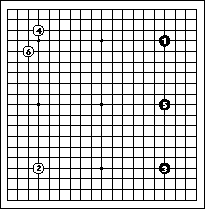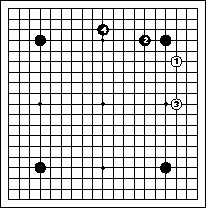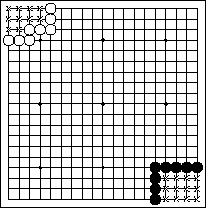
Two people sit face to face with the board between them. Notice one side of the grid is slightly longer than the other. The players should sit on the shorter ends. The stronger player takes the white stones. If the two player's abilities are similar, they choose for color. First, the older player takes a handful of white stones, and the younger player guesses odd or even. (If there is a language barrier, you can put one or two stones down instead of saying "odd" or "even.") The guesser takes black if he or she guesses correctly. Black has an advantage. The player with the black stones begins. Take one stone between your index and middle fingers and place it on a point on the board. You can put your stone on any point you like, including the points along the edges. Next your opponent plays a stone on another point, and so on. The players are referred to as "Black" and "White." The number on each stone in the diagram is the order in which it is played. To review the diagram below, find the point on your board where Black 1 was played and put the first stone there, then put down White 2, and so on. Each stone is played one at a time. You can't play two stones at once.
Territory consists of the points surrounded by stones of the same color. The points surrounded by the black stones are black territory, and the points surrounded by the white stones are white territory. Each point of territory is marked with an X. By counting the number of Xs, we see
that Black has twelve points and White has ten points, so if this is the end of the game, Black wins by two points.
|
|
Problems with our site?
Email:
webmaster@samarkand.net


